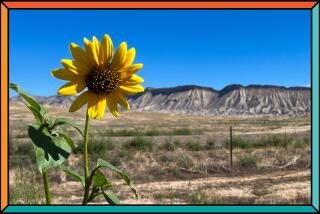Gardening : Southwest Garden Suits Southland Climate : Flowers: The new-found popularity of the spare, beautiful planting style is driven by our region’s parched conditions.
Southern Californians have long admired Santa Fe-style architecture for its simple, flowing lines that echo the ancient dwellings of the Southwest pueblos.
Navajo rugs, Hopi pottery and other elements of Southwest chic have found a place in local interior design, but the spare Southwest garden style, though favored by cactus and succulent growers, has attracted fewer followers.
“Even when my clients had Mediterranean or Santa Fe-style houses,” said Los Angeles landscape designer Ivy Reid, “they still wanted English cottage gardens. They thought drought-tolerant gardens had to be ugly.”
Reid and other designers find that the past year’s triple whammy of drought, heat and cold has changed attitudes. Many homeowners have started to think about Southwesternizing their landscapes when fall planting season rolls around again.
Gardeners developed the Southwest style in response to their area’s extreme, sometimes bizarre weather patterns, which are deprived of the ocean’s moderating influence. These are some of the lessons they learned about choosing and using plants.
Use plants that are drought-tolerant and develop quickly. New Mexico’s Albuquerque is not only drier than Los Angeles (average annual precipitation of eight inches compared to our 15-inch historic average), but also has a far shorter growing season.
The emphasis is on planting rugged species, such as desert willow (Chilopsis linearis) , that are quick to become established. Southern Californians who heed this advice might plant California lilacs (Ceanothus) . If planted in the early fall, they develop such a strong root system that they generally require minimal care by their first summer in the ground.
Use plants that like heat. This is not the same as drought tolerance. Pride-of-Madeira is an excellent drought-tolerant plant in cool coastal areas that doesn’t appreciate the heat (and cold) of interior valleys. Desert willow and other Southwest natives thrive on heat, producing bursts of pink, trumpet-shaped flowers following a bout of 100 degree weather.
Other plants, though not native to the Southwest, tolerate drought and love heat. Oleander (Nerium oleander), chaste tree (Vitex agnus-castus) and Rose-of-Sharon (Hibiscus syriacus) revel in the high heat of our valleys. Imagine your relief to see your plants enjoying every minute of an August heat wave instead of wilting and shriveling.
Use plants that are hardy to cold. El Paso, Tex., has mild winters compared to much of the Southwest, but even there gardeners expect more than 50 nights of freezing temperatures each year.
Plants native to Texas we grow, including Mexican evening primrose (Oenothera berlandieri), red yucca (Hesperaloe parviflora) and Gaura (Gaura lindheimeri), take all the cold we can give them. The Mediterranean’s heat-loving Rose-of-Sharon and chaste tree can also withstand temperatures of 10 below. Both just laughed at the record-breaking freeze we had in December.
Use a mixture of plant types. Cacti are wonderful garden accents. They look terrific with Mediterranean and Southwestern architecture, but they don’t have to dominate a Southwest garden. For that matter, you can plant in the Southwest style with no spines or thorns at all. Red yucca, whose relatives in the century plant family are often fiercely thorny, has perfectly soft, harmless leaves.
Red yucca typically blooms the first summer after planting, and its flowers are a beautiful shade of coral pink. They are available at Desert-to-Jungle Nursery (3211 W. Beverly Blvd., Montebello; (213) 722-3976), where you can also find a red yucca variety with soft yellow flowers that is new to Southland gardens.
Ornamental perennial grasses, also featured at Desert-to-Jungle, are softening touches for Southwest landscapes. The most striking is a silver-blue dune grass (Elymus arenarius) that spreads slowly by runners when grown under dry conditions.
Keep plantings simple. This may be the most important lesson of the Southwest style--and the hardest for local gardeners to learn.
In the desert, shrubs grow widely spaced so they don’t compete for water. This ecological need translates in garden design to a simple, spare style in which deep-rooted trees and shrubs are favored over all but the toughest perennials and annuals.
In a Southwest garden a mature cottonwood or gnarly pinyon pine is a centerpiece that doesn’t need to be surrounded with water-loving bedding plants. In contrast, some Los Angeles gardeners think of our native coastal live oaks as simply a canopy under which to grow azaleas or impatiens.
When gardeners can see the beauty in an old oak with just a mulch of granite pebbles underneath, they’ve learned the lesson of the Southwest: Use plants whose deep-rooted self-reliance allows them to flourish under the most trying conditions.






